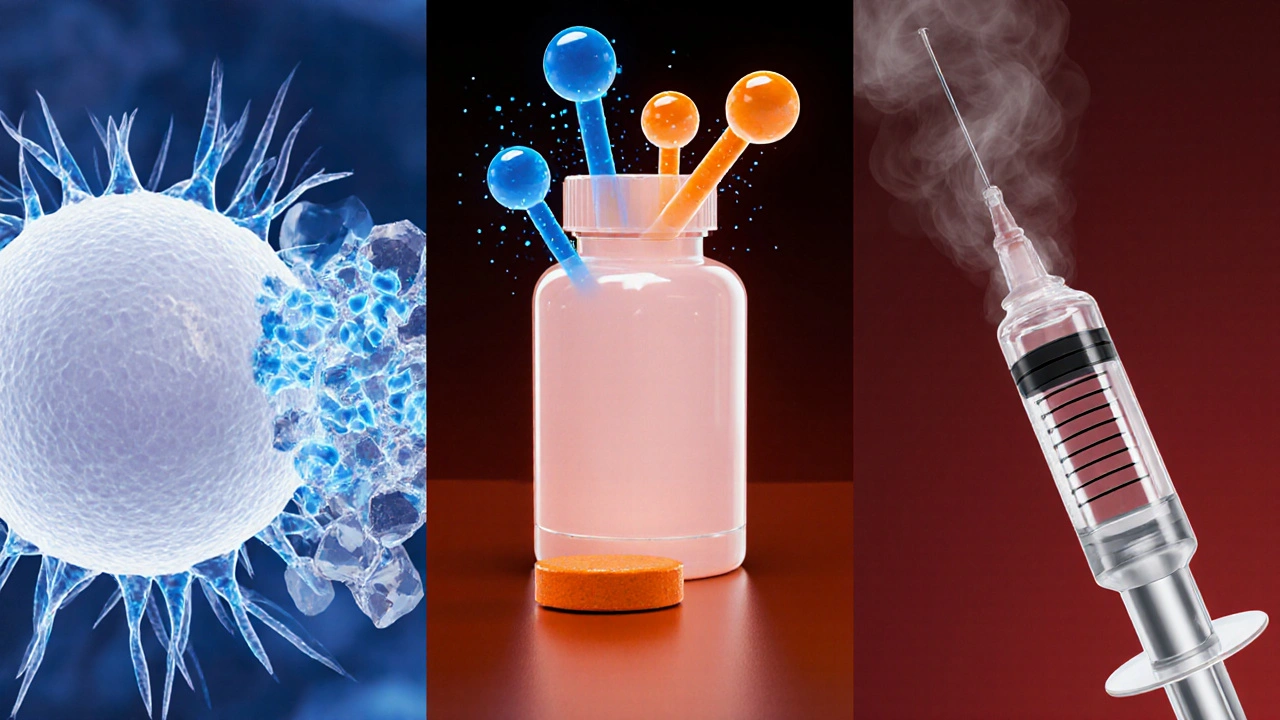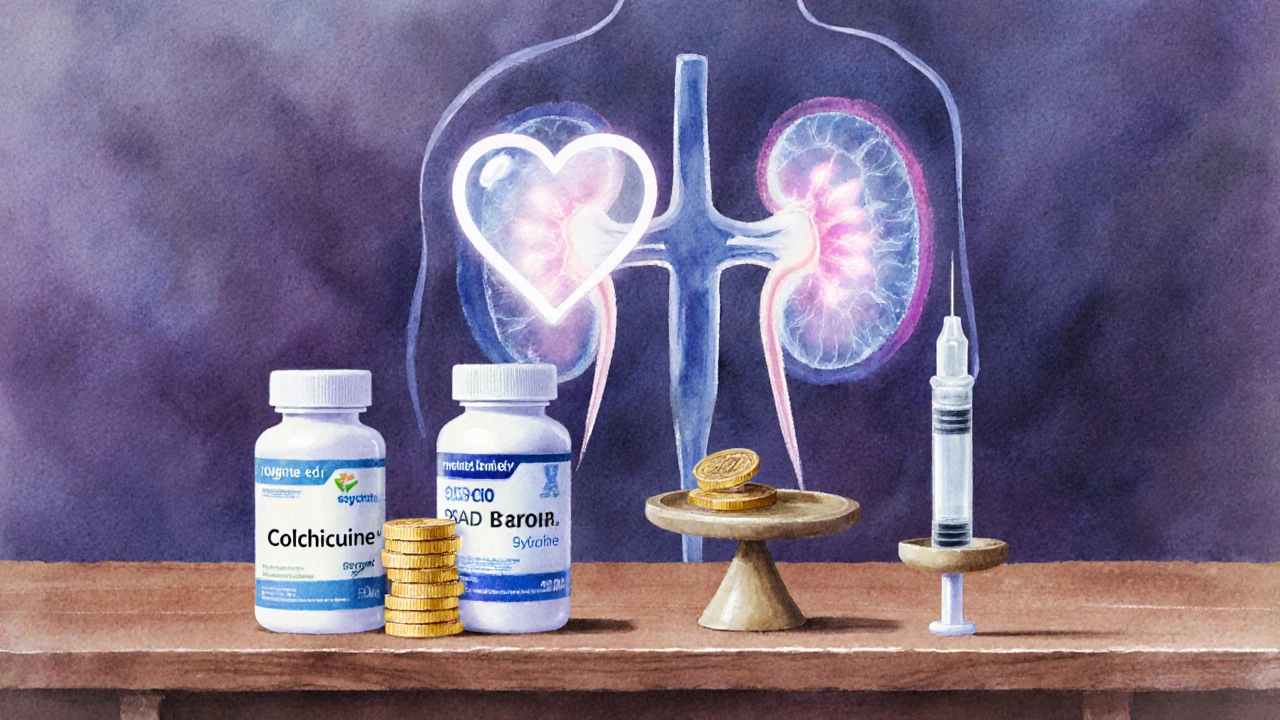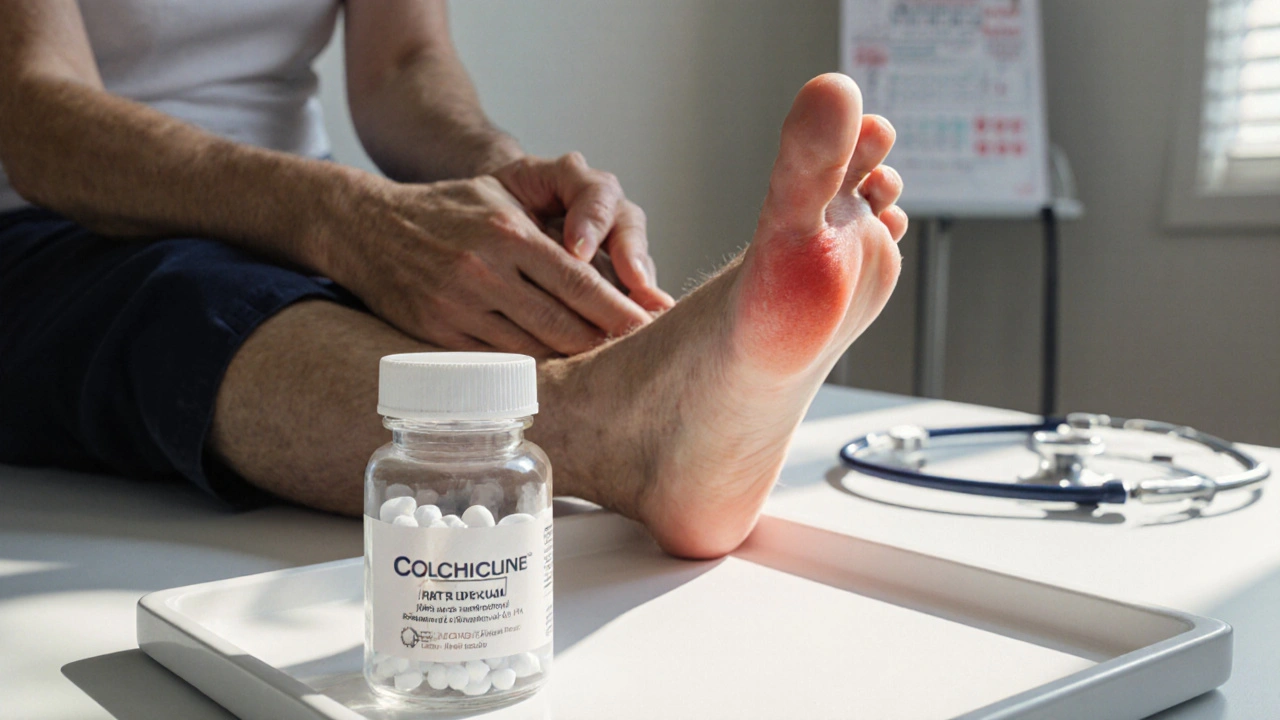Gout Treatment Selector
Personal Treatment Assessment
Key Takeaways
- Colchicine works by stopping microtubule formation, which curbs the inflammatory cascade in gout attacks.
- Common alternatives include NSAIDs, corticosteroids, IL‑1 inhibitors, and urate‑lowering drugs used for flare prevention.
- Side‑effects differ: colchicine can cause GI upset, NSAIDs risk stomach bleeding, steroids raise blood sugar, and biologics are pricey.
- Choosing the right option depends on kidney function, drug interactions, cost, and how quickly you need relief.
- When used correctly, colchicine remains one of the fastest‑acting gout flare treatments.
When you hear the word Colchicine is an ancient alkaloid derived from the autumn crocus that blocks microtubule assembly, dramatically reducing inflammation during acute gout attacks, you might picture a niche medication for a rare disease. In reality, it’s a first‑line drug for millions of gout sufferers worldwide. Yet it’s not the only game‑changer on the market, and many patients wonder whether a different pill might be safer or work faster. This guide breaks down colchicine’s strengths, its most common rivals, and how to match the right drug to your personal health profile.
How Colchicine Actually Works
Gout flares are sparked when uric acid crystals lodge in a joint, triggering the NLRP3 inflammasome-a protein complex that releases the inflammatory messenger IL‑1β. Colchicine binds to tubulin, a protein needed for building microtubules, and stops them from forming. Without functional microtubules, white blood cells can’t migrate to the crystal site, and the inflammasome stays quiet. The result is rapid pain relief, often within a few hours of the first dose.
Because its action is mechanical rather than hormonal, colchicine works even if you’re already on a urate‑lowering drug like allopurinol. That’s why doctors usually prescribe it for an acute flare while you stay on chronic therapy to prevent future attacks.
Typical Dosing and Safety Profile
A standard regimen starts with a 1.2mg loading dose (often two 0.6mg tablets) followed by 0.6mg one to two hours later, then 0.6mg every 12hours until the flare subsides-usually no more than three days. Most adults tolerate this well, but the drug’s narrow therapeutic index means you have to watch for:
- Diarrhea or nausea (the most common side‑effect, reported in up to 25% of users).
- Muscle pain or weakness, signaling possible myopathy-especially if you’re also on a statin.
- Blood‑cell changes like low white‑blood‑cell counts, which can be serious in rare cases.
Kidney impairment dramatically increases colchicine levels, so the dose must be cut in half for CrCl<30mL/min. Pregnant women are generally advised to avoid it unless the benefit outweighs the risk.

Top Alternatives to Colchicine
When colchicine isn’t suitable-say, because of kidney disease, drug interactions, or intolerable GI upset-doctors turn to a handful of well‑studied options.
1. Non‑steroidal Anti‑Inflammatory Drugs (NSAIDs)
Indomethacin and Naproxen are the classic choices. They inhibit cyclooxygenase (COX‑1 and COX‑2), lowering prostaglandin production and easing pain within 30-60minutes. Typical doses are indomethacin 50mg three times daily or naproxen 500mg twice daily for up to 10days.
Pros: Fast acting, inexpensive, widely available.
Cons: High risk of stomach ulcers, especially in older adults; can raise blood pressure and worsen heart failure; contraindicated in severe kidney disease.
2. Corticosteroids
Prednisone (or oral methylprednisolone) works by suppressing the entire immune response, not just the inflammatory pathway triggered by crystals. A common taper starts at 30mg daily for 5days, then halves every two days.
Pros: Effective even when NSAIDs are risky; useful for patients with multiple comorbidities.
Cons: Can raise blood glucose, cause mood swings, and increase infection risk; not ideal for long‑term use.
3. IL‑1 Inhibitors (Biologic Agents)
Drugs like Canakinumab and Anakinra directly block IL‑1β, the cytokine that fuels gout flares. Canakinumab is given as a single 150mg subcutaneous injection; anakinra is 100mg daily for 3‑5days.
Pros: Very rapid relief, excellent for patients with severe kidney disease or contraindications to NSAIDs and colchicine.
Cons: Expensive, insurance may limit use, injectable route can deter some patients.
4. Urate‑Lowering Therapies Used for Flare Prevention
While not meant for immediate pain relief, drugs like Allopurinol, Febuxostat, and Probenecid keep serum urate < 6mg/dL, dramatically reducing the number of future attacks. If you’re already on one of these and still get frequent flares, a short course of colchicine or an alternative is added during the acute phase.
Side‑Effect Snapshot
| Drug | Typical Side‑Effects | Key Contra‑indications | Cost Tier |
|---|---|---|---|
| Colchicine | Diarrhea, nausea, muscle pain | Severe kidney impairment, drug interactions (e.g., CYP3A4 inhibitors) | Moderate |
| Indomethacin | Stomach ulcer, headache, renal strain | Peptic ulcer disease, heart failure, CKD | Low |
| Prednisone | Blood sugar rise, mood changes, weight gain | Uncontrolled diabetes, active infection | Low |
| Canakinumab | Injection site reaction, infection risk | Active severe infection, hypersensitivity | High |
Decision‑Making Checklist
Before you or your clinician settle on a treatment, run through this quick checklist. It helps you weigh the pros and cons against your own health picture.
- Kidney function: If eGFR<30mL/min, avoid standard colchicine dosing and most NSAIDs.
- Cardiovascular risk: NSAIDs can raise BP and trigger fluid retention; steroids can worsen cholesterol.
- Drug interactions: Check for CYP3A4 inhibitors (e.g., clarithromycin) that boost colchicine levels.
- Cost & insurance coverage: Biologics may need prior authorization; generic NSAIDs and colchicine are usually covered.
- Speed of relief needed: For rapid control, colchicine or an IL‑1 inhibitor is best; steroids work within 24hours; NSAIDs act in 1-2hours.
- Past tolerance: If you’ve experienced severe diarrhea on colchicine, consider a steroid or IL‑1 blocker.

Practical Tips for Using Colchicine Safely
- Start with the lowest effective dose-some clinicians use 0.6mg twice daily for mild attacks.
- Take the dose with food or a glass of milk to lessen stomach upset.
- Stay hydrated; dehydration raises colchicine concentration.
- Notify your pharmacist if you’re on a statin-monitor for muscle symptoms.
- If diarrhea lasts more than 48hours, stop the drug and call your doctor.
When to Call Your Healthcare Provider
Even though gout flares are painful, most resolve within a week. Seek medical help if you notice any of the following:
- Fever>38.5°C (101.3°F) alongside joint pain.
- Severe swelling that interferes with walking.
- Persistent vomiting or diarrhea lasting beyond two days.
- Signs of infection at the joint (red streaks, pus).
- Kidney stones or blood in the urine after a flare.
Frequently Asked Questions
Can I use colchicine together with NSAIDs?
Yes, a short combined course is sometimes prescribed for severe attacks, but your doctor should watch for kidney strain. The total NSAID dose may need to be reduced to avoid additive GI side‑effects.
Is colchicine safe for people with heart disease?
Generally, yes, as long as kidney function is adequate. However, if you’re on digoxin or certain anti‑arrhythmic drugs, dose adjustments are needed to prevent toxicity.
How long can I stay on colchicine as a preventive measure?
Low‑dose prophylaxis (0.6mg once or twice weekly) is often continued for years, especially if you have frequent flares or are starting urate‑lowering therapy that can initially trigger attacks.
What should I do if I miss a colchicine dose?
Take the missed dose as soon as you remember, unless it’s almost time for the next one. Never double‑dose; extra colchicine raises the risk of severe toxicity.
Are there natural ways to reduce gout flare frequency?
Staying hydrated, limiting high‑purine foods (red meat, seafood), reducing alcohol, and maintaining a healthy weight all lower serum urate. These lifestyle steps complement any medication you’re on.
Bottom Line
If you can handle a short bout of stomach upset, colchicine remains one of the fastest, most reliable ways to tame a gout flare. When kidney disease, drug interactions, or intolerable side‑effects block its use, NSAIDs, steroids, or IL‑1 inhibitors provide solid backups-each with its own trade‑offs. The best choice hinges on your individual health profile, how quickly you need relief, and what your insurance will cover. Talk openly with your doctor, run the decision checklist, and you’ll land on a treatment plan that gets you back on your feet without unnecessary risk.


Honestly, colchicine feels like a double‑edged sword. It kicks the pain fast, but the stomach upset can ruin your day.
Colchicine’s rapid action comes from blocking microtubule assembly, which means white blood cells can’t get to the crystal site. If your kidneys are decent (CrCl >30) the standard 1.2 mg loading dose followed by 0.6 mg works fine. For patients on statins you might need to shave the dose in half to avoid muscle issues. The GI upset is the most common side‑effect, so taking it with food helps a bit. Overall, it’s a solid first‑line option if you need relief in a couple of hours.
Do you know why pharma pushes colchicine? They want you to stay dependent!!! The drug is ancient, yet the FDA pretends it’s a miracle. They hide the fact that it can cause lethal toxicity if mis‑dosed!!! Also, the “statin interaction” story is just a scare‑tactic to sell more supplements!!!
While the chart is informative, the prose feels overly technical. A layperson might struggle with terms like NLRP3 inflammasome. 😊
Colchicine has been a cornerstone in gout management for decades, and its mechanism of action is both elegant and effective. By binding to tubulin, it prevents the formation of microtubules, which in turn halts the migration of neutrophils to the urate crystal‑laden joint. This blockade stops the inflammatory cascade early, often delivering pain relief within a few hours of the first dose. The standard acute regimen starts with a 1.2 mg loading dose, split into two 0.6 mg tablets taken 30 minutes apart, followed by 0.6 mg every 12 hours until the flare subsides, typically not longer than three days. For patients with normal renal function (CrCl > 30 mL/min), this dosing is generally safe, but dose adjustments are mandatory in renal impairment to avoid accumulation and toxicity. One of the most frequent complaints is gastrointestinal upset-nausea, vomiting, or diarrhea can affect up to a quarter of users, especially if the loading dose is taken on an empty stomach. Co‑administration with statins raises the risk of myopathy, so clinicians often halve the colchicine dose in those scenarios or monitor creatine kinase levels closely. Compared with NSAIDs, colchicine offers faster pain control without the same risk of gastric bleeding, making it attractive for patients who cannot tolerate ibuprofen or naproxen. However, unlike NSAIDs, colchicine does not provide significant anti‑inflammatory strength in massive flares, where corticosteroids or IL‑1 inhibitors may be preferred. Cost is another consideration; colchicine is usually inexpensive, but brand‑name formulations can be pricey in certain markets. Patients should also be educated about the narrow therapeutic window-overdose can lead to severe pancytopenia, renal failure, or even death. In practice, counseling on taking the medication with food, staying hydrated, and recognizing early signs of toxicity can markedly improve outcomes. Regular follow‑up visits help catch any delayed side effects, and adjusting the regimen based on kidney labs is standard practice. So, while not perfect, colchicine’s risk‑benefit profile is hard to beat for quick relief. 😊
Really? The article repeats the same bullet points over and over… i dont see any new info… the layout is kinda messy….
Reading through the breakdown, I’m reminded how important it is to match the therapy to the patient’s overall health. If someone has reduced kidney function, the dose of colchicine needs to be cut, otherwise you risk toxicity. NSAIDs can be great for fast pain control, but they’re a nightmare for people with hypertension or a history of ulcers. Corticosteroids are a solid backup, especially when you can’t use the other options, but you have to watch blood sugar. IL‑1 inhibitors are pricey, yet they’re a lifesaver for chronic, refractory gout. Bottom line: talk with your rheumatologist, weigh pros and cons, and don’t self‑medicate blindly.
I’ve noticed several grammatical errors in the section describing colchicine’s mechanism; it should read “binds to tubulin, preventing microtubule formation” rather than “binds tubulin preventing”. Also, the term “uric acid crystals” needs a hyphen when used as an adjective, e.g., “uric‑acid‑induced flares”. Proper punctuation improves readability for a global audience.
Great overview! 🙌
From a pharmacodynamic perspective, colchicine exhibits a narrow therapeutic index, necessitating vigilant dose titration to mitigate cytotoxicity. The drug’s affinity for tubulin disrupts the polymerization cascade, thereby attenuating neutrophil chemotaxis and inflammasome activation. In contrast, non‑steroidal anti‑inflammatory agents exert cyclooxygenase inhibition, which, while efficacious, predisposes to gastrointestinal mucosal compromise. Therefore, clinicians must stratify patients based on renal clearance (CrCl), concomitant statin therapy, and comorbid metabolic syndrome to optimize therapeutic outcomes while minimizing iatrogenic sequelae.
If you’re new to gout meds, start by checking your kidney numbers and any other drugs you’re on. Talk to your doctor about the best starting dose, and don’t hesitate to ask why a particular option is suggested. Knowledge is power, and the right plan can keep you moving pain‑free.
Colchicine works fast.
In the grand scheme of human suffering, gout is a reminder that even our bodies can betray us with crystal‑induced pain. Yet, modern medicine offers us tools-colchicine, NSAIDs, steroids, biologics-to turn that betrayal into a fleeting episode. The choice of tool reflects not just biology but our values: speed, safety, cost, and dignity.
Love the quick comparison table! 😎👍
Super helpful breakdown! I especially appreciate the note on statin interactions-saved me from a nasty surprise.
Colchicine is fast but can upset your stomach
Everyone raves about colchicine, but have you considered that most of the data comes from small, industry‑funded trials? Real‑world evidence suggests a higher rate of GI adverse events, and the dosing guidelines often overlook genetic polymorphisms in CYP3A4 that affect metabolism. So, take the hype with a grain of salt.
The article feels like a copy‑paste from a pharma brochure. Nothing new.
Thanks for the clear guide! Feeling more confident about my treatment options now. 😊
Wow, a “quick comparison” that takes you 10 minutes to read-truly speedy.